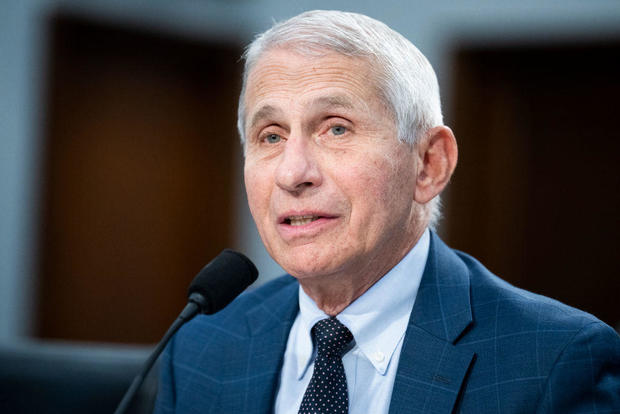New COVID variant BQ.1 now makes up 1 in 10 cases nationwide, CDC estimates
[ad_1]
In just over a month since a new COVID variant known as BQ.1 was first named, that strain and a descendant called BQ.1.1 have already grown to make up more than 10% of new infections across the country, according to updated estimates published Friday by the Centers for Disease Control and Prevention.
“When you get variants like that, you look at what their rate of increase is as a relative proportion of the variants, and this has a pretty troublesome doubling time,” Dr. Anthony Fauci, the president’s chief medical adviser, said in an interview with CBS News.
It comes as federal health authorities have been bracing for a widely-expected resurgence of COVID-19 this fall and winter. BQ.1 variants have already outpaced many rival strains in European nations from England to Germany, which have already seen renewed waves begin.
The CDC had previously bundled BQ.1 and BQ.1.1 with their shared parent BA.5 in the agency’s weekly “Nowcast” estimates. BQ.1 was first named by scientists in early September, based on sequences spotted across the U.S. and several other countries.
BQ.1 and BQ.1.1 each currently make up an estimated 5.7% of infections around the country, the agency said. The remainder of BA.5, which had dominated a wave of cases over the summer, has shrunk to 67.9% of circulating variants.
“While BQ.1 and BQ.1.1. represent a small but fast-growing subset of the Omicron variant, BA.5 remains the dominant lineage in the United States,” CDC spokesperson Kristen Nordlund said in a statement.
BQ.1 and BQ.1.1 also appear on track to overtake the only other strain that still outnumbers them: BA.4.6, which currently makes up 12.2% of infections.
Nordlund said the agency had not listed BQ.1 and BQ.1.1 separately in the agency’s previous weekly variant reports because they “were circulating at less than 1% in the empiric data.”
Out of all regions, the New York and New Jersey area has the largest proportion of BQ.1 and BQ.1.1 infections. Around 20% of infections there are already from BQ.1 or BQ.1.1, the CDC estimates.
News of the new variants’ growth comes as COVID-19 metrics are still largely improving nationwide.
Only around 1% of Americans live in counties seeing “high” COVID-19 Community Levels, where the CDC urges indoor masking and other steps to curb the virus. Less than half of counties are seeing community transmission bad enough to warrant requiring universal masking in hospitals and nursing homes, under recent federal guidance.
But data from Health and Human Services Region 2, which spans New York and New Jersey, has also tracked a recent uptick in COVID-19 hospitalizations and nursing home infections.
“As much as you want to feel good about the fact that cases are down, hospitalizations are down, we don’t want to declare victory too prematurely. And that’s the reason why we’ve got to keep our eye out on these emerging variants,” Fauci said.
Concerns about immunity and monoclonal antibodies
Fauci also echoed worries that the variant’s mutations might evade medications like Evusheld, which is a key antibody drug used to help protect immunocompromised Americans from the virus.
“That’s the reason why people are concerned about BQ.1.1, for the double reason of its doubling time and the fact that it seems to elude important monoclonal antibodies,” said Fauci.
Tom Williams/CQ-Roll Call, Inc via Getty Images
A spokesperson for AstraZeneca said they did not currently have data on how BQ.1 might impact its drug.
The FDA warned doctors earlier this month of data suggesting other variants now on the rise around the country could threaten high-risk patients who had relied on Evusheld’s protection.
BQ.1 is one of a wide-ranging “soup” of new strains that scientists have been tracking, over concerns that their mutations at specific positions on the spike protein of the virus could fuel a surge.
Experts have cited the “sizable number of unique mutations” in variants like BQ.1 in speculating that it could evade immunity people have from prior infections or vaccination.
However, so far little is known about what impact these mutations might have in affecting the severity of the disease, which would require further studies in animals and humans.
Fauci said he expected the updated COVID boosters from Pfizer-BioNTech and Moderna, which were recently expanded to children as young as 5, would be able to help curb a potential surge fueled by BQ.1.
“The bad news is that there’s a new variant that’s emerging and that has qualities or characteristics that could evade some of the interventions we have. But, the somewhat encouraging news is that it’s a BA.5 sublineage, so there are almost certainly going to be some cross protection that you can boost up,” he said.
More than 14.7 million Americans have so far gotten an updated COVID booster, which includes a component aimed at the BQ.1’s parent BA.5.
That works out to around 7% of the 209 million who were initially eligible for the shots when they were first greenlighted last month.
However, after accelerating in the wake of the initial booster rollout, figures published late Thursday by the CDC show the daily pace of new COVID shots is now slowing.
The shortfall between the pace of updated boosters and the typical uptake of the annual flu vaccine by this time of year has also widened.
“That’s the thing that’s so frustrating for me and for my colleagues who are involved in this, is that we have the capability of mitigating against this. And the uptake of the new bivalent vaccine is not nearly as high as we would like it to be,” Fauci added.
[ad_2]
Source link











